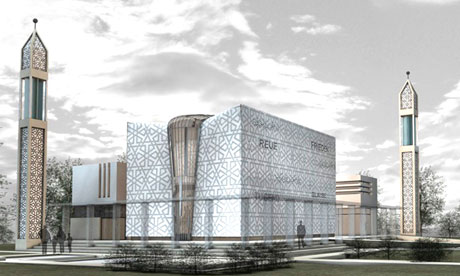
An artist's impression of the proposed mosque in Norderstedt, Germany, with wind turbines in the minarets. Image: Selcuk Unyilmaz.
Al Salamu 'Alaykum.
News that a small Muslim community in Norderstedt, Germany, has pioneered renewable energy sources by placing a wind turbine within the minaret of their mosque comes as a welcome surprise to most. Yet for some commentators the minaret continues to symbolise the march of an intolerant Islam intent on proselytising liberal Europe, a view made clear in 2009 when a Swiss referendum banned the construction of any new minarets.
To those versed in the proclivities of Islamic art and architecture, however, the mosque and its minaret have always stood as positive examples of syncretism.In the seventh century, during the earliest stages of Islam, Muslims conducted their prayers in simple courtyard-like structures (or simply open spaces), which had partially covered areas to protect worshippers from the fierce Arabian sun. As Islam spread out of the deserts of Arabia and into the cityscapes of Damascus and Cairo, the rapidly expanding Muslim population required houses of worship that continued to meet their social and spiritual requirements. There are very few doctrinal guidelines as to what specifically constitutes a mosque (the only essential requirement being direction towards Mecca) and so Muslims either legally appropriated and modified existing structures or created completely new buildings.
The mosques that followed are magnificent and innovative examples of architecture that are paradoxically original through the way they borrowed from other cultures.
Take the eighth-century Great Mosque of Damascus: with its central nave, corner towers and sumptuous golden mosaics one could be excused for mistaking it for a late-antiquity church. On closer inspection, however, one notices the complete absence of figurative imagery in the building's mosaics that are so ubiquitous in Byzantine architecture. Here, the figures have been replaced by fantastic foliate arabesque and detailed depictions of classical architecture to align with the Islamic sanction against figural imagery in the mosque.
One can also hear the melodious call to prayer from one of the mosque's minarets. The Great Mosque of Damascus was formerly a church purchased from the Christians and transformed into a mosque; the minarets themselves were previously Christian corner towers. Prior to Damascus, the Muslim call to prayer was conducted from the tallest part of the urban landscape (eg on top of a house or mosque wall). When the Muslims came to Damascus, naturally the call to prayer was performed from the top of the church tower and thus, the architectural feature that is the minaret came to be.
Damascus is of course not the only example of cultural borrowing. One can witness the same phenomena in the Dome of the Rock in Jerusalem, which has its own take on the pre-Islamic centralised shrine architecture of the Levant (eg the nearby Church of the Holy Sepulchre).
Perhaps the most obvious example of adaptive architecture is in Istanbul, Turkey, where the old and the new have sat opposite each other for almost 500 years: on one side is the magnificent sixth-century basilica Hagia Sofia, and on the other is the early 17th-century Blue Mosque, a monument that bears startling resemblance to its Byzantine predecessor yet remains unequivocally unique in appearance.
Traditional Muslim societies therefore had no qualms about absorbing and learning from the cultures that they encountered and adjusting them within the philosophical framework of Islam: Islamic architecture is, and always has been, a medium for syncretism rather than proselytisation.
Fast-forward almost 1,400 years to the eco-friendly minaret in Germany. In Europe minarets no longer serve the practical function of calling people to prayer that they once did in the eighth century and instead remain as symbols or bastions of a traditional aesthetic.
What better way to return to the ingenuity of the Islamic architectural tradition than to transform the minaret once again into a highly productive and practical architectural feature which still retains its aesthetic and symbolic responsibilities.
Such resourcefulness is the perfect riposte to critics who accuse Muslim communities of self-marginalisation as well as social and religious "backwardness". Especially in Europe, where the apparent failings of "multiculturalism" seem to be the issue of contention, it is highly refreshing to see Muslim communities so emphatically adjusting their sails and letting the turbulent winds carry them to the shores of reinvention.
By Bilal Badat for the Guardian, UK.
http://www.guardian.co.uk/commentisfree/belief/2011/jun/24/eco-mosque-wind-turbine
Wa'laykum Salam.
This comment has been removed by the author.
ReplyDelete